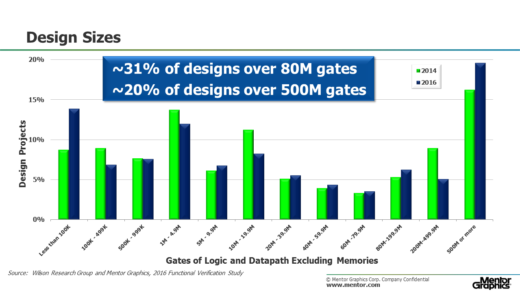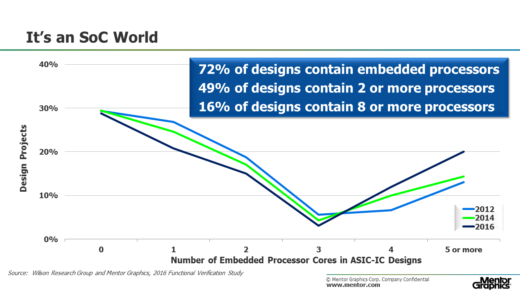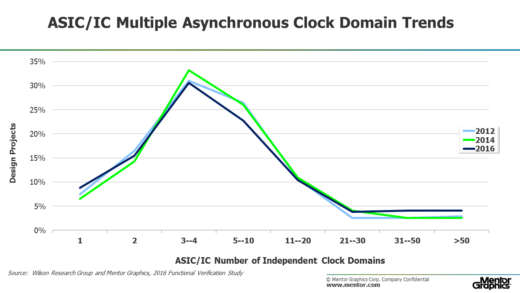Part 7: The 2016 Wilson Research Group Functional Verification Study
ASIC/IC Design Trends
This blog is a continuation of a series of blogs related to the 2016 Wilson Research Group Functional Verification Study (click here). In my previous blog (click here), I focused on FPGA design and verification trends. I now will shift the focus of this series of blogs from FPGA trends to ASIC/IC trends.
In this blog, I present trends related to various aspects of design to illustrate growing design complexity. Figure 1 shows the trends from the 2014 and 2016 studies in terms of active ASIC/IC design project by design sizes (gates of logic and datapath, excluding memories). Keep in mind that Figure 1 represents design projects, not silicon volume.
One interesting observation from this year’s study is that there appeared to be a large increase in design projects working on designs less than 100K gates. This was somewhat of a surprise. Perhaps it is due to a number of projects working on smaller sensor chips for IoT devices. At any rate, it is important to keep this in mind when observing some of the verification technology adoption trends. The reason is typically these very small projects do not apply advanced verification techniques, which can bias the overall industry verification technique adoption trends in some cases.

Figure 1. ASIC/IC Design Sizes
The key takeaway from Figure 1 is that the electronic industry continues to move to larger designs. In fact, 31 percent of today’s design projects are working on designs over 80M gates, while 20 percent of today’s design projects are working on designs over 500M gates.
But increased design size is only one dimension of the growing complexity challenge. What has changed significantly in design since the original Collett studies is the dramatic movement to SoC class of designs. In 2004, Collett found that 52 percent of design projects were working on designs that includ one or more embedded processors. Our 2012 study found that the number of design projects working on designs with embedded processors had increased to 71 percent, and has been fairly consistent since that point in time as shown in Figure 2.
Another interesting trend is the increase in the number of embedded processes in a single SoC. For example, 49 percent of design projects today are working on designs that contain two or more embedded processors, while 16 percent of today’s designs include eight or more embedded processors. SoC class designs add a new layer of verification complexity to the verification process that did not exist with traditional non-SoC class designs due to hardware and software interactions, new coherency architectures, and the emergence of complex network on-a-chip interconnect.

Figure 2. ASIC/IC Design Sizes
In addition to the increasing number of embedded processors contained within an SoC, it is not uncommon to find in the order of 120 integrated IP blocks within today’s more advanced SoCs. Many of these IP blocks have their own clocking requirements, which often present new verification challenges due to metastability issues involving signals that cross between multiple asynchronous clock domains.
In Figure 3, we see that 91 percent of all ASIC/IC design projects today are working on designs that have two or more asynchronous clock domains.

Figure 3. Number of Asynchronous Clock Domains in ASIC/IC Designs
One of the challenges with verifying clock domain crossing issues is that there is a class of metastability bugs that cannot be demonstrated in simulation on an RTL model. To simulate these issues requires a gate-level model with timing, which is often not available until later stages in the design flow. However, static clock-domain crossing (CDC) verification tools have emerged as a solution used to automatically identify clock domain issues directly on an RTL model at earlier stages in the design flow.
In my next blog (click here) I plan to discuss the growing ASIC/IC design project resource trends due to rising design complexity.
Quick links to the 2016 Wilson Research Group Study results
- Prologue: The 2016 Wilson Research Group Functional Verification Study
- Understanding and Minimizing Study Bias (2016 Study)
- Part 1 – FPGA Design Trends
- Part 2 – FPGA Verification Effort Trends
- Part 3 – FPGA Verification Effort Trends (Continued)
- Part 4 – FPGA Verification Effectiveness Trends
- Part 5 – FPGA Verification Technology Adoption Trends
- Part 6 – FPGA Verification Language and Library Adoption Trends
- Part 7 – ASIC/IC Design Trends
- Part 8 – ASIC/IC Resource Trends
- Part 9 – ASIC/IC Verification Technology Adoption Trends
- Part 10 – ASIC/IC Language and Library Adoption Trends
- Part 11 – ASIC/IC Power Management Trends
- Part 12 – ASIC/IC Verification Results Trends
- Conclusion: The 2016 Wilson Research Group Functional Verification Study


